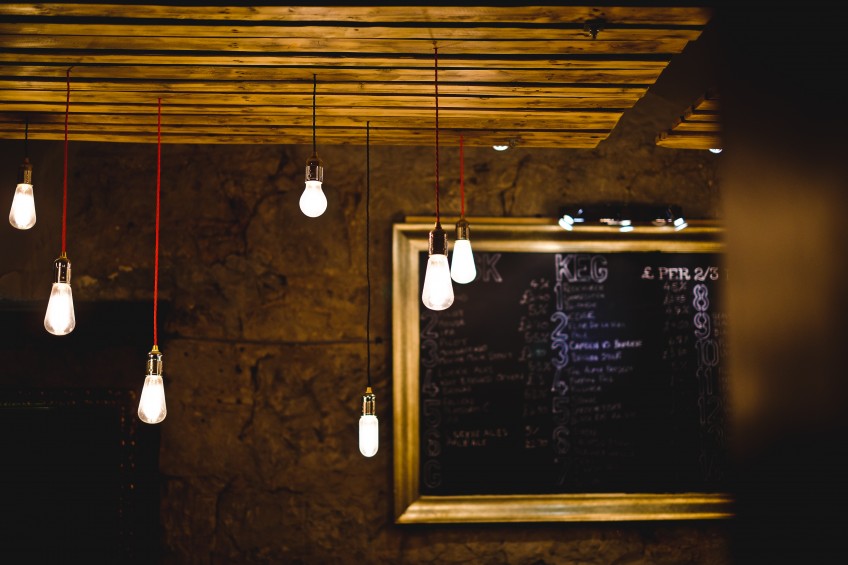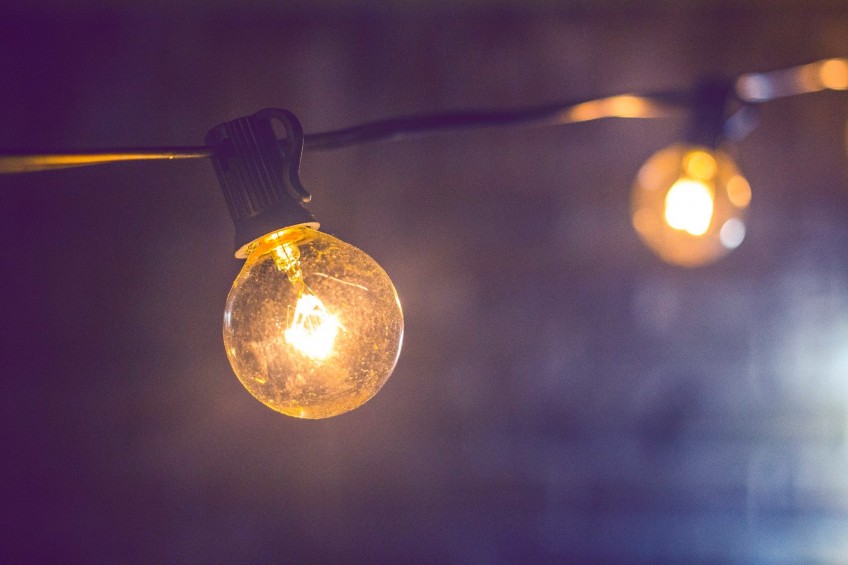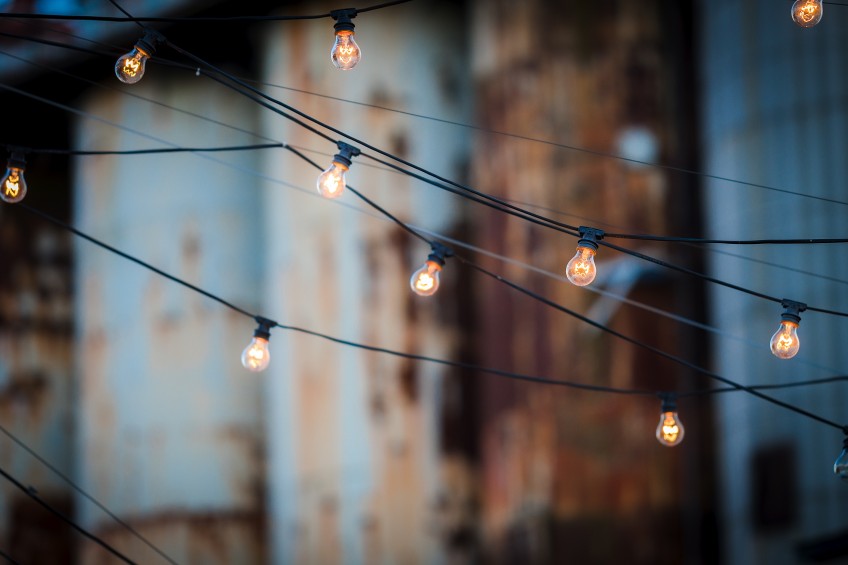Introduction
Light is created by a wide range of methods ranging from just burning stuff to advanced microchips. Knowing the difference between each technology will ensure that you use the best for each application and have efficient and effective lighting in your home.
Step by step
Incandescent
When Thomas Edison invented the “modern” light bulb in 1879, it revolutionized the world. What he created was called an incandescent bulb and consisted of a burning filament encased in a vacuum or inert gas. Fast forward 100+ years and not much has changed with this technology. While effective, it is not very efficient, with much of the electricity being consumed as heat rather than given off as light. It also has the shortest life spans of any technologies, with most lamp types only lasting about 1,000 hours.
Incandescent lighting is known for its warm glow. It also works very well in dimming applications, as it can make a steady drop down to 0% without any flicker, leaving the faintest of romantic warmth. In applications that value aesthetics over efficiency, this is a good application. However, advances in LED dimming technology have started to minimize even this advantage.
The standard incandescent lamp runs off of line voltage (typically 110v at home), which mean there are no other components that might fail outside of the bulb. When they do fail, they can be disposed anywhere since there is no hazardous waste used in their construction. However, do take care as a broken glass light bulb can make for a nasty cut!
When a incandescent bulb is turned on, it is immediately at 100% full light output. There is no warm-up period to worry about. Another advantage of incandescent lights is that they are very cheap to buy. However, the cheapest part of owning a light bulb is buying it, as the real cost is in the power it consumes, so don’t focus too much on this advantage.
Summary: Incandescent
|
Energy Efficiency |
Poor |
|
Life |
Poor |
|
Aesthetics |
Great |
|
First Cost |
Good |
Fluorescent
Fluorescent lights were the next advancement and came along in the early 20th century. However, it wasn’t till the energy crunch of the 1970’s they became the preferred option. They are about 5x more efficient than an equivalent incandescent and provide a life span 20x better. These advantages make them a staple in commercial settings, from big box stores to offices. Unfortunately, they are also famous for providing a harsh, unflattering light and eventually giving away to a pulsating strobe effect that some say causes headaches. While homeowners grudgingly adopted them, most really don’t like them. Long linear fluorescents are mainly only found in garages and closets, but compact fluorescents are very common throughout the home.
Fluorescents function by arcing electricity through a glass tube filled with a gas and coated with phosphors. This coating is what allows the bulb to give off a white light. This light is typically on the higher end of the color temperature spectrum, which is why they have a more sterile appearance than incandescent. Fluorescent lamps also contain trace elements of mercury, which makes them dangerous when broken and requires they be properly disposed of as hazardous waste. Don’t throw these out in the garbage! Recycle them at your local home improvement store.
Fluorescent lamps are not powered by line voltage like incandescent, but have a ballast that regulates input voltage and frequency. This introduces another level of complication and potential failure. Although ballasts last longer than bulbs, often times if more than one lamp is out it is an indication of a bad ballast. Note that compact fluorescents have an integrated ballast, which is that white plastic piece at the base of the bulb.
Given the ballasted nature of fluorescents, they are also notorious for taking a while to “warm up”. Cheap fluorescents common in the big box stores are even more susceptible to this downside. Most homeowners have experienced this as they turn on their lights and it takes a few minutes for them to reach full brightness. This is especially a concern in exterior applications as bulbs are subjected to cold weather that intensifies this issue and are often used for security application where full brightness right away is very important.
Due to their design of arcing electricity from one end of a tube to the other, fluorescents were initially somewhat limited in their design. The most common was the T12 (12/8” or 1 ½“ diameter) in 4’, 2’, or U-Bend configurations. Eventually these were shrunk to the T8 (8/8” = 1” diameter) and less common T5 (more popular in Europe) diameters while staying in the common lengths. However, in the 1970’s someone figured out how to wrap the tube in to a spiral and gave us the Compact Fluorescent. These gained ground in the residential market as prices dropped through the 1980’s and 1990’s. While often encouraged as the alternative to energy hog incandescent, the Compact Fluorescent lamps lack the aesthetics and excellent dimming qualities of incandescent.
Summary: Fluorescent
|
Energy Efficiency |
Good |
|
Life |
Good |
|
Aesthetics |
Poor |
|
First Cost |
Good |
LED
Light Emitting Diode (LED) lights are a byproduct of the semi-conductor industry and while first developed in the 1970’s, they did not become a common source of lighting until the 2000’s. The past 5 years have seen incredible advancement with LED lighting, with efficiencies going up and prices coming down by more than 50%. They last longer, are more durable, and look better than any fluorescent alternative and are the only real solution you should be considering for 99% of applications.
Rather than burning a filament (incandescent) or arcing a gas (fluorescent), LED have a small solid state diode that produces light when electrified. This light can then be passed through a phosphor coating to produce the desired color temperature of white light. While traditionally LED’s were known for their high color temperature (5000-6500k), almost bluish, light, recent improvements in technology have made them more pleasing at the popular 2700-3500k range preferred by homeowners.
The energy efficiency of LEDs is far above any of their competitors, and nearly 10x incandescent. This means you can get the same light output (measured in lumens) from a much lower input power (measured in watts). While incandescent lighting is often around 15 lumens/watt (typically 60W light bulb = 900 lumens), LEDs are now over 100 lumens per watt (the same 900 lumens can be produced with less than 10 watts of power, or about 110 lumens/watt). At the same time the LED can last over 50,000 hours, where the incandescent only lasts 1,000 hours. That means you can go 20 years without changing a good quality LED light bulb where you would have had to change the incandescent equivalent every 6 months…all while it cost you 10x as much to use!
When compared to fluorescent, the energy savings difference isn’t as large since fluorescent are already around 75 lumens/watt. For our example 900 lumen output bulb the fluorescent may consume about 13 watts vs. the LEDs 9 watts. However, the fluorescent will only last about 20,000 hours, with many low-quality versions not even reaching that, so you still get longer life without the downside of fluorescents like mercury content, poor light quality, slow warm up, fragile glass, and ugly looks. LEDs have also made improvements in dimming technology and are generally better at doing so than fluorescents, even though they still aren’t as good as incandescent.
Due to their compact size and lack of a ballast, LEDs have been adapted to pretty much all of the common light bulb shapes. This sizing is only restricted by the fact that LEDs require a substantial heat sink to dissipate heat away from the diode. While the efficiency of LED is due to their ability to produce light without all the excess waste given off as heat, they do still produce a small amount of heat and the chip used is very sensitive to this. Think of it like your computer that requires a fan to keep the processor cool. This is why you often see a finned aluminum base on LEDs, which gives a larger surface area to draw heat away and dissipate it away. This is also why LEDs tend to be heavier than other technologies. With LED, weight is often an indicator of quality.
The biggest downside to LED is their initial cost. Thankfully, we’ve seen huge drops in prices over the past several years. Once you consider the energy and lifespan advantages of LED, there are few reasons to use anything else even given the small cost premium. The only time we may recommend something different is for an area that still needs the aesthetic qualities of an incandescent.
We love LEDs, and think you will too.
Summary: LED
|
Energy Efficiency |
Great |
|
Life |
Great |
|
Aesthetics |
Good |
|
First Cost |
Getting Better! |
Halogen
Halogen lighting is almost the same as incandescent for all intents and purposes. The difference is that the glass is filled with halogen gas which improves the efficiency and life slightly. This technology is usually found in higher wattage flood light or spot light applications. The most common bulb is the 90W PAR38 that you may have in an exterior security fixture.
Since halogens have the same instant-on and excellent dimming qualities as incandescent, they are sometimes used as alternatives to save a little energy without the downside of fluorescents or LEDs. They won’t save nearly as much energy or last as long as those options, but are otherwise a good alternative.
Unlike other lamp types, Halogen lights need to be handled with gloves as the oils from your fingers will shorten the lamp life. Once they die, you can dispose of in the same way as an incandescent or LED (no hazardous waste).
Pretty much everything regarding incandescent applies to halogen. You could replace them with fluorescent, but we recommend you use LED.
Summary: Halogen
|
Energy Efficiency |
Poor |
|
Life |
Poor |
|
Aesthetics |
Good |
|
First Cost |
Good |
HID (High Intensity Discharge)
High Intensity Discharge (HID) lights are less common than the first four types in residential applications but occasionally you will find them in exterior settings. The two main types of HID are Metal Halide and High Pressure Sodium. Most streetlight and parking lot light fixtures are one of these types, although LED has been starting to replace them due to the energy lifespan advantages. You can usually spot a High Pressure Sodium by the yellowish light it gives, compared to a much whiter light from a Metal Halide.
Both of these light types are powered by a ballast and have large glass lamps. Wattages are typically higher, starting around 50-70 watts and going all the way up to thousands of watts for applications like stadium lighting. They are often powered by higher voltages so care needs to be given working on these.
Chances are you don’t have any of these at your house unless you have a big flood light, some pole lights around your driveway, or maybe a flagpole light. We’d recommend that you get a professional to service these due to the higher voltages often found and some special handling characteristics of these lamp types.
If you do have these and would like to change them, we’d recommend you switch to a full LED fixture. There have been a lot of imported LED bulbs called “corncob” lights that claim to be a direct replacement for HID application. The problem with these is that they don’t have a good method for dissipating heat from the LED diodes and experience very high failure rates. A new LED fixture has the diodes integrated in and a heat sink designed to pull heat away. Additionally, an exterior lighting fixture is specially designed to spread light in a certain way given the reflectors inside. If you just swap the bulb with a corncob LED you’ll likely mess up this design.
Changing to an LED fixture for exterior lighting takes more thought, design, and expertise than we can cover in this article, so consider hiring a local professional if you have these, or send us an email and we can help with your questions.
Summary: HID
|
Energy Efficiency |
Poor |
|
Life |
Poor |
|
Aesthetics |
Good |
|
First Cost |
Poor |
Other types…
The lamp types above cover 99% of what you will ever find in a residential application. However, occasionally something weird pops up like an induction light (kind of like fluorescent. Great life, decent energy quality, considered a replacement for HID but were short lived because LEDs are better). We won’t take the time to cover any of these here, but if you find something you can’t figure out from the main 4-5 types, let us know and we’ll do what we can to help you figure it out!
Summary
There you have it! You now know all you need to know on the pros and cons of the most common residential lighting technologies. You likely have a mix of these in your house currently, but we’d encourage you to replace them with LED and plan to just buy those going forward.
What we didn’t cover here in detail is lamp types and sizes, color temperature, efficacy, color rendering, and manufacturers! That’s a lot more detail and all important, so look for more posts and videos coming soon on each.
Interested to learn more about lighting? Read our article on lighting efficiency or light bulb shapes and sizes.




